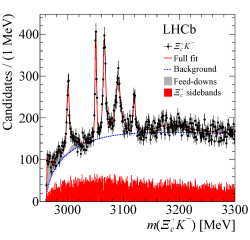 This week, the LHCb experiment at CERN's Large Hadron Collider announced the discovery of five new resonances (very short-lived particles), known as excited Ωc (Omega_c) baryons. Baryons are composed of three fundamental particles called quarks. Well-known examples of baryons are the protons and neutrons that are found in atomic nuclei. A proton is made of two “up” quarks and one “down” quark, bound together via the strong nuclear force. The Ωc baryons are similar, but they are made from two “strange” quarks and one “charm” quark. These are like heavier (i.e., more massive) versions of the up and down quarks. The Ωc baryons do not exist inside atomic nuclei and can only be produced on earth in certain particle physics experiments such as the CERN Large Hadron Collider.
This week, the LHCb experiment at CERN's Large Hadron Collider announced the discovery of five new resonances (very short-lived particles), known as excited Ωc (Omega_c) baryons. Baryons are composed of three fundamental particles called quarks. Well-known examples of baryons are the protons and neutrons that are found in atomic nuclei. A proton is made of two “up” quarks and one “down” quark, bound together via the strong nuclear force. The Ωc baryons are similar, but they are made from two “strange” quarks and one “charm” quark. These are like heavier (i.e., more massive) versions of the up and down quarks. The Ωc baryons do not exist inside atomic nuclei and can only be produced on earth in certain particle physics experiments such as the CERN Large Hadron Collider.
CERN’s Large Hadron Collider discovers new sub-atomic particles which shed light on ‘strong force’
The first Ωc baryon (the ground-state) was studied over 20-30 years ago. By giving energy to the quarks inside the baryon, it is possible to “excite” the baryon into a new state, somewhat like the way that atoms can be excited into a new state. These states typically have different orbital angular momentum between the constituent quarks and the baryon is more massive. This is what we see in the data, where we have five very distinct peaks at five different values of the mass from 3000 MeV up to about 3100 MeV. For comparison, the proton has a mass of about 940 MeV (MeV is a convenient unit used for measuring particle masses).
These five new states were expected to exist, but had never been seen before. It is only with the CERN LHC that we have the ability to produce these states in large numbers, which can then be detected through the excellent performance of the LHCb detector. The next steps will be for LHCb collaborators to try to measure the quantum numbers of these states to see if they match up with theoretical predictions that are based on the theory of the strong force (Quantum Chromodynamics - QCD). This should be able to confirm how we think QCD operates or lead to refinement of the theorists predictions.
This discovery shows the amazing potential of the LHCb experiment to further understand QCD. It will help theorists better understand how quarks and gluons bind together into baryons and, in particular, how the spin correlations between the constituent quarks play a role in that binding. This will have interesting implications as we search for more exotic multi-quark states such as pentaquarks and tetraquarks using data from LHCb.
The LHCb experiment is a collaboration of around 750 scientists from 69 different universities and laboratories in 16 countries, including around 40 academics, postdocs and PhD students from the Universities of Edinburgh and Glasgow.
Dr. Greig Cowan, LHCb physicist at the University of Edinburgh says "What is fantastic is that this observation was performed with only a subset of the currently available data. We have already recorded more and will continue to operate until the end of 2018 (LHC Run 2), meaning that there could be many more surprises waiting to be discovered.”
Dr. Daniel Craik, postdoctoral researcher at the University of Edinburgh adds "Between 2019-2021 we will upgrade the LHCb detector, ready to start again for LHC Run 3. I anticipate that there will be much more to learn about the strong nuclear force once we get our hands on that data!"
More information:
